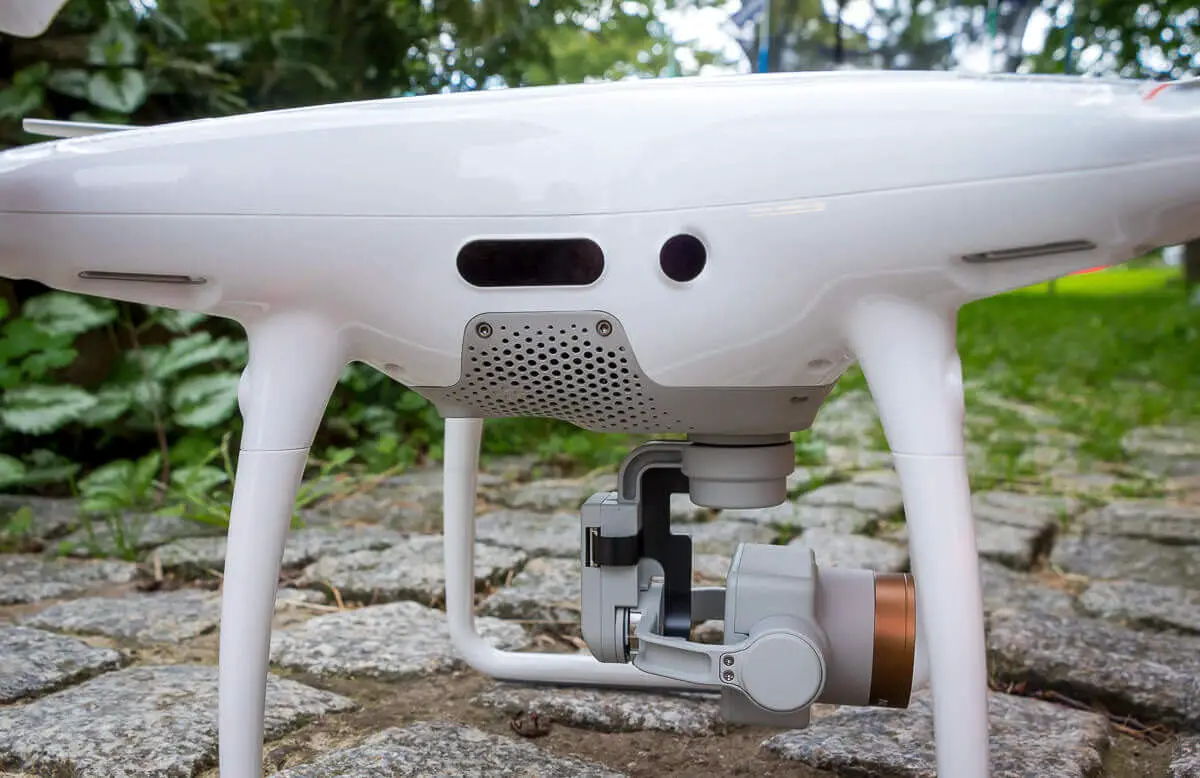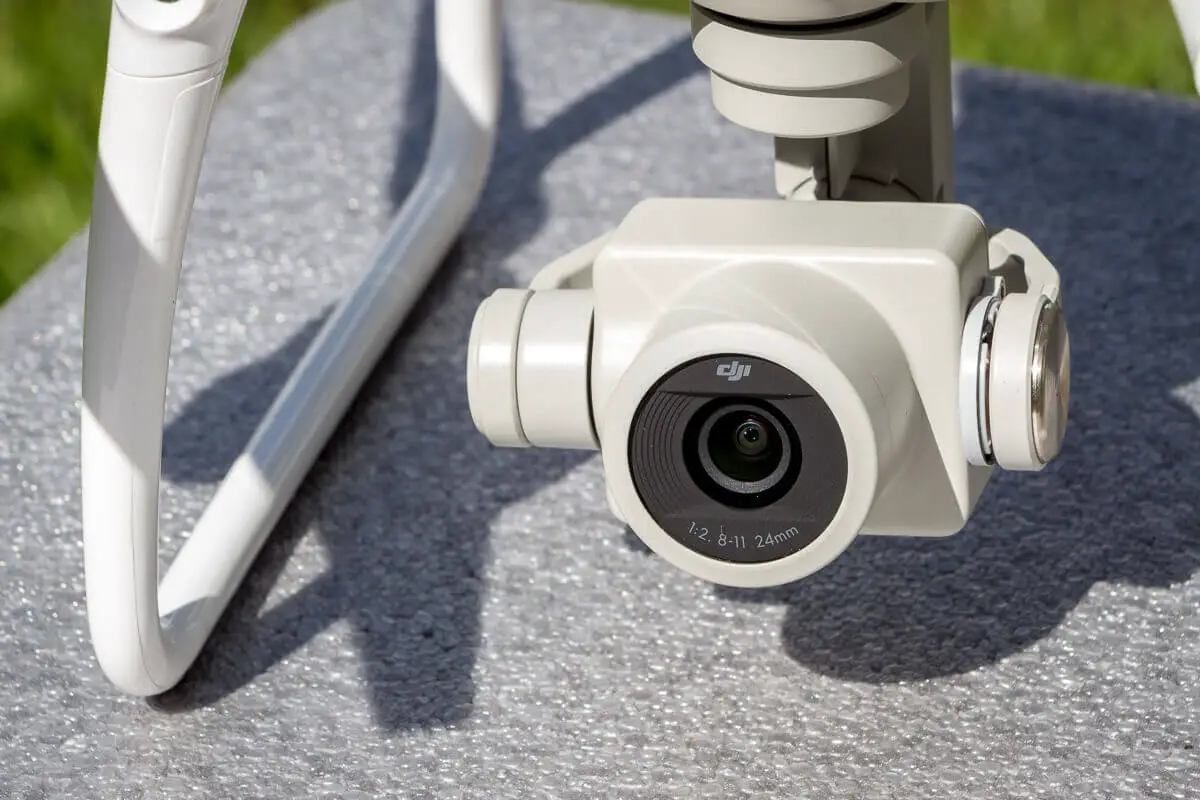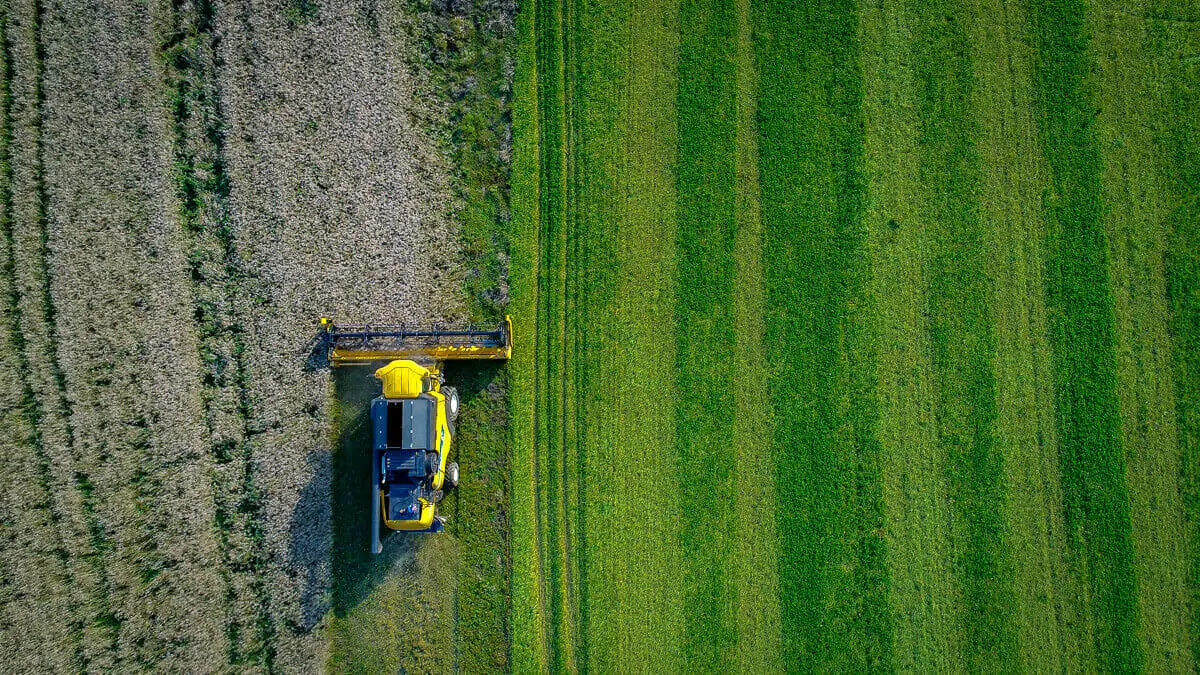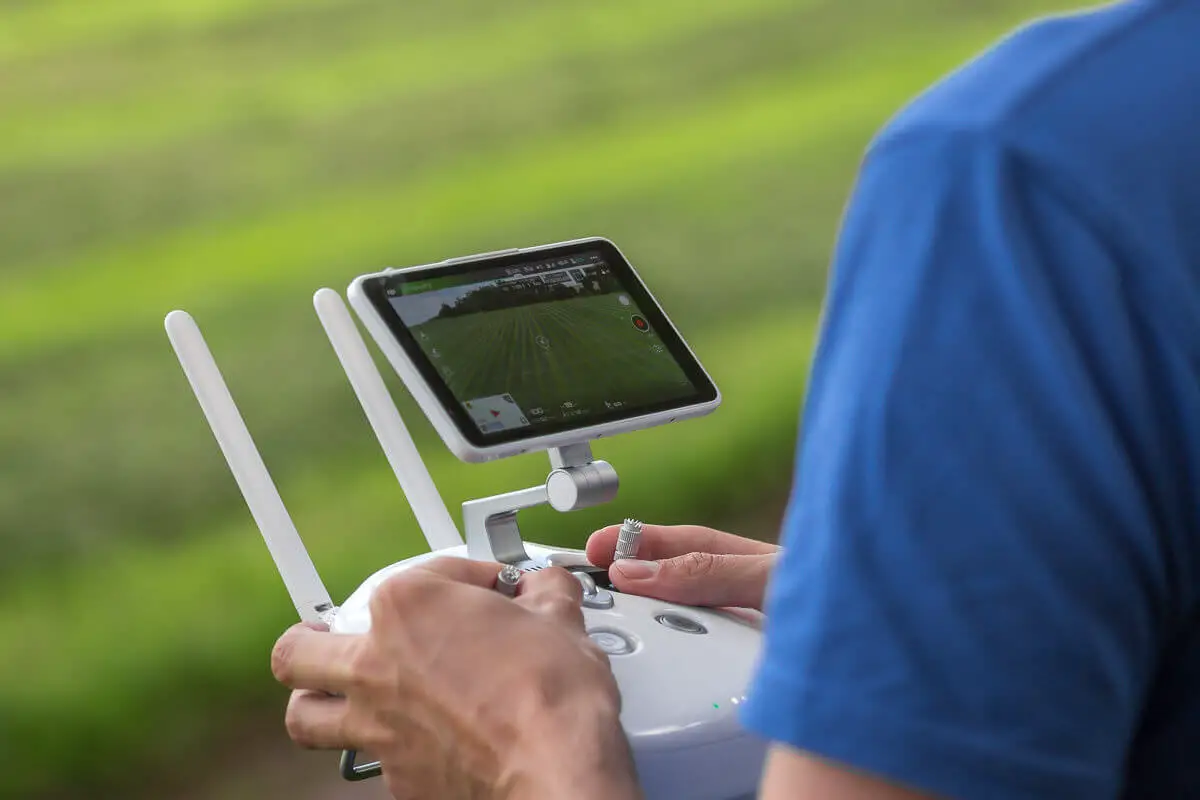My Review of the DJI Phantom 4 (Standard, Advanced and Pro)
Last update on 15.02.2020 | 0 Kommentare

With the DJI Phantom 4, the Chinese market leader for drones has dramatically revised its famous quadrocopter. We looked at the Copter and showed what the technical marvel is all about and for whom the purchase is worthwhile.
The DJI Phantom has undergone a remarkable transformation. While the previous Phantom models all had a very similar structure, the Phantom 4 already stands out from its predecessors.
The transformation of the DJI Phantom
The body of the Phantom 4 drone looks significantly beefier, and the arms are slimmer than the previous Phantom. Overall, the Quadrocopter thereby gives a robust and high-quality impression.
As with the 3 series, the Phantom 4 has a fixed gimbal system for image stabilization with a built-in camera that cannot be replaced. The big difference is that the 3-axis gimbal is now connected to the body and the damper plate is no longer visible. The components are made of magnesium, which should cause a more stable copter and less vibration. Presumably, Jello effects are thus finally a thing of the past.

Also new are the push-and-release propellers, which can now be mounted even faster. The new propeller system is handy for getting the quadrocopter more quickly in the air on the go.
Another innovation is the batteries. The new intelligent 4S LiPo batteries promise a 25% longer flight time compared to the DJI Phantom 3 Professional. DJI advertises in this context with a maximum flight time of a considerable 30 minutes. In our tests, we were able to achieve similar flight times. This is, of course, a substantial improvement, but also has a significant disadvantage. Anyone who has already flown a phantom drone from DJI can not reuse their old batteries. The Phantom 4 batteries have an entirely new design. You should not lose sight of this aspect with a new purchase because new cells are costly. For that reason alone, it would be out of the question for me to buy one of the predecessor models.
Charged is a battery of the DJI Phantom 4 within an hour. If you want to load several cells at the same time, we can recommend this charger to you.
The features of the Phantom 4
As usual with the DJI Phantom models, the latest model also has the proven security features. These include the Failsafe / Return to Home feature, which automatically allows the quadrocopter to return in the event of an incident (such as disconnection, low battery voltage, etc.).
With Tapfly DJI has introduced a flight function, which should be exciting, especially for beginners. On the preview image on your tablet, tap on a point with your finger. Then the DJI Phantom 4 starts its flight to this position thanks to Tapfly and evades even obstacles.
Particularly interesting in the Phantom 4 is the function called ActiveTrack. With ActiveTrack, you mark a specific object on your smartphone or tablet. The drone then follows the subject independently when it moves. Such maneuvers usually require some experience and skill. Thanks to ActiveTrack it will now be very easy for you to perform such operations. As a result, you’ll be able to capture high-quality movies that are reminiscent of professional camera shots.
In addition to a GPS module, the satellite-based localization of the copter by a GLONASS receiver (GLONASS is the Russian alternative to the American GPS) even more precise. The advanced optical positioning system allows safe flights even in situations where GPS / GLONASS reception is not possible (for example, indoor or difficult terrain/valleys).

Significant assistance for drone pilots is the integrated anti-collision system. If your quadcopter moves towards an obstacle during a flight the DJI Phantom 4 brakes shortly before it and prevents a collision. The collision protection is not only excellent for beginners. Depending on the drone’s design, there are differences in which directions obstacle detection works. I will introduce you to the different features of the individual Phantom 4 models in the course of the article.
For experienced drone aircraft, the DJI Phantom 4 offers a sports mode in which the drone reacts much faster, and speeds of up to 72 km / h can be achieved. Especially if you enjoy fast flights, the new sports mode will inspire you! You can quickly switch to another mode with a toggle switch on the remote control during a flight.
DJI Phantom 4: Standard vs. Advanced vs. Pro
The DJI Phantom 4 is available in three different versions: the DJI Phantom 4 Standard, the DJI Phantom 4 Advanced and the DJI Phantom 4 Pro.
All three models have the anti-collision system (DJI Vision Positioning System) described above on board, which uses various sensors to detect objects in front of and below the drone. This allows the drone to slow down or avoid obstacles. The VPS can detect objects up to a distance of 10 meters.
Also, the DJI Phantom 4 Pro has even more sensors for obstacle detection on the back and infrared sensors on the left and right sides. This way, obstacles can be detected in almost all directions. However, I have to say that the side infrared sensors are activated only in Beginners mode, in TabFly and ActiveTrack mode and are thus rarely used. You should not rely too much on the anti-collision system.
The Phantom 4 Advanced and the Phantom 4 Pro have an improved camera compared to the standard version. The standard version has the same specifications as the DJI Mavic Pro. If that’s enough, I recommend the Mavic Pro as it’s easier to carry. The DJI Phantom 4 Standard is no longer sold in the official DJI-Store, but can still be purchased through other dealers.
If you have higher demands on the camera, you should have a look at the Advanced or the Pro. The details of the camera I describe in the next paragraph.
In addition to the additional sensors of the anti-collision system, there is an insignificant difference between the Advanced and the Pro. The remote control on the Advanced only communicates in the 2.4 GHz frequency range. Besides, the DJI Phantom 4 Pro can transmit at 5.8 GHz, making you more independent of interference from other wireless networks (such as WiFi networks). This makes it even less likely that there will be disconnections.
| DJI Phantom 4 Pro | DJI Phantom 4 Advanced | DJI Phantom 4 Standard | |
| Weight | 1388 gram | 1368 gram | 1380 gram |
| Camera Sensor | 1″ CMOS Sensor 20 Megapixel | 1″ CMOS Sensor 20 Megapixel | 1/2,3″ CMOS Sensor 12,4 Megapixel |
| Max. Video Resolution | 4k with 60 fps | 4k with 60 fps | 4k with 30 fps |
| Obstacle Avoidance | VPS sensors forward, back and down. Also, infrared sensors on the left and right sides. | VPS sensors forward and down. | VPS sensors forward and down. |
| Frequency for FPV Livestream | 2,4 GHz and 5,8 GHz | 2,4 GHz | 2,4 GHz |
The camera of the Phantom 4 Advanced and Phantom 4 Pro
As already mentioned, the DJI Phantom 4 Quadrocopter is equipped with a fixed camera incl. Gimbal. Depending on the model, however, the camera characteristics differ. While the camera specifications of the Phantom 4 Standard (videos in 4K with 30 fps, 12-megapixel photos in DNG) are very similar to those of the DJI Mavic Pro, the camera in the Advanced and Pro versions is much more mature. That’s why I especially want to introduce these camera features.

The camera of the DJI Phantom 4 Advanced and Pro
The camera of the Phantom Advanced and Pro has a mechanical shutter, eliminating rolling shutter artifacts in videos. Also, the camera has a 1 “CMOS sensor, which can capture better images. Images are saved with 20 megapixels. By comparison, the Phantom 4 Standard and the Mavic Pro both only have a 1/2.3 “sensor with 12.4 megapixels.
New in the Phantom range is an adjustable aperture from f / 2.8 to f / 11 in the Advanced and Pro, allowing you to enjoy more creative travel.
Thanks to the larger sensor, you can now also take night shots at a higher ISO than 100. In our previous tests, the image noise up to an ISO of 800 was still within reasonable limits. Remember that Drone laws regulate night flights in most countries.
In addition to the popular video codec H.264, the Phantom 4 films can also be stored in the modern codec H.265. This codec requires less storage space with the same image quality and is thus considered a favorite in the future. Currently, many devices such as tablets and smartphones do not support this codec yet. So the codec plays a minor role for us. With the camera of the Phantom 4, you are prepared for the developments of the next years.

The recorded video footage can be easily edited after the drone flight with color profiles (including D-Log and Cine-D). Photos can be taken with DNG / Raw.
The most significant strength of the DJI Phantom 4 Advanced / Pro is the sophisticated camera for me. According to my previous experience, this camera is the best in this segment. So if you are looking for excellent photos and videos, you should buy the DJI Phantom 4 Advanced or DJI Phantom 4 Pro.
The quadrocopter with the plus
The DJI Phantom 4 comes standard with a remote control to attach your smartphone or tablet. This means for you that you have to connect your mobile device every time. I find that a bit annoying and smartphones are not always bright enough to see the FPV image transmission well enough on the screen.
That’s why DJI also offers a Plus version for the Phantom 4. In this version, a display with the Android operating system is directly installed on the remote control, that with 1,000 cd / cm2 is almost twice as bright as my iPhone 6. This allows me to recognize more in the FPV live stream and can perform the flight better. In direct sunlight, it can still happen that the preview image is difficult to see.

The remote control of the DJI Phantom 4 with monitor
However, the permanently installed monitor on the remote control also has disadvantages: Firstly, the display cannot be changed. Indeed, it would sometimes be more enjoyable to use a larger monitor. Also, no other apps can be installed on the remote control.
In sum, however, I find that the benefits of integrated remote control outweigh the benefits. I think it’s great how fast the DJI Phantom 4 Advanced / Pro Plus can be started. In our tests, there were also no problems with disconnections, so I highly recommend to buy the Phantom 4 in the Plus version.
My experiences and criticism of the DJI Phantom 4
The DJI Phantom 4 can fly beautifully in all versions. Compared to the DJI Mavic Pro, the Phantom 4 is a bit sluggish and slows down more slowly when you let go of the joysticks. But that is not necessarily a disadvantage for me. I get along well with the remote control and am thrilled with the Phantom 4.
However, there are a few things that DJI could still optimize.
One thing has strongly disappointed me: The propellers often protrude into the picture on forwarding flights. I know the same problem of the Phantom 2, but I had hoped that DJI got the problem in the meantime. If you are also struggling with this issue, you have three possible solutions:
- You reduce the speed in flight. As a result, the Phantom 4 does not tilt forward so much.
- You tilt the gimbal a bit forward, so the propellers are not visible on your video anymore.
- You film the desired motive in the backward flight. In this case, the drone tilts in the other direction, so that the propellers disappear from the picture.
If you know the solution and pay attention to the propellers, then you can get the problem quickly under control.
As a last point of criticism, I would like to mention the fact that the DJI Phantom 4 is quite loud. We are already used to the sound of multicopters, but I find the hum of the DJI Phantom 4 quite intrusive. So far we have not objectively measured the noise level and compared it directly with other drones, but in my opinion, the DJI Phantom 4 is louder than comparable aircraft. This can be especially problematic if you want to film in quiet areas where other people want to relax.
The criticisms are bearable for me, and we now use the DJI Phantom 4 very often. The benefits outweigh in my opinion clearly, so I like to accept the small disadvantages.
Buy DJI Phantom 4
As you now know, there are several variants of the quadrocopter. The DJI Phantom 4 Advanced (1.549 € RRP) is slightly cheaper than the DJI Phantom 4 Pro (1.699 € RRP). In the Plus version, an additional 300 euros will be added.
The following items are included with the DJI Phantom 4 Pro +:
- 1 aircraft DJI Phantom 4 Pro
- 1 remote control with 5.5 “Android screen
- 2 propeller sets
- 1 intelligent 4S LiPo battery
- 1 battery charger with power cable
- 1 gimbal clamp for safe transport
- 1 microSD card with a capacity of 16 GB
- 1 USB OTG cable
- 1 micro USB cable
- 1 transport box
- Various instructions[/one_half_last]
I think the included microSD card is a bit tight and would, therefore, recommend you to order a quick microSD card with 64 GB. Besides, it always makes sense to have at least two spare batteries in your luggage. If you are still looking for a suitable backpack, then I can recommend this to you here. The backpack has been proven for several years with us.
Incidentally, after your purchase, you should immediately think about taking out drone insurance! All the critical information we have put together in the linked article.
Preparation: What you have to consider before the first flight
If you have decided on a DJI Phantom 4, there are a few things left to do before the first quadrocopter flight.
First, you should load all the batteries. In the meantime, you can familiarize yourself with the user manual and remove protective elements from the Phantom 4 (note: there is a foam pad on the gimbal that can easily be overlooked).
Then you have to turn on and activate your new drone. To do this, you first need a DJI account, which you can create here. Then log in via your smartphone/tablet or the integrated screen of the remote control (in the Plus version). To activate, you will then be led through several steps where you u.a. to give a name to your Phantom 4
Activation did not work for us right away (Activation Failed) because we used a plus sign (+) in the name of the drone. Once we removed the plus in the name, the activation went immediately.
After activation, the copter checks the DJI servers for firmware updates. Carry it through, and then you’re ready to start. Now you can go outside and fly for the first time with your new quadrocopter. The first time you take off with an unmanned aerial vehicle, you can use Beginner mode to get used to flying slowly.

A conclusion to the DJI Phantom 4
The DJI Phantom 4 is an excellent drone with outstanding flight characteristics. It is comfortable to control and safe to control. However, instead of the Phantom 4, I would recommend the DJI Mavic Air to beginners as it is easier to transport. I recommend the DJI Phantom 4, especially for photographers and videographers. The camera features of the Phantom 4 Advanced and the Phantom 4 Pro are, in our estimation, the best in this price segment.
Do you already have experience with the DJI Phantom 4? Then please leave us a review in the comments to this drone. We are looking forward to your opinion!
 EU-wide drone regulations: Classes of drones explained
EU-wide drone regulations: Classes of drones explained
 New EU-wide rules for drones from 2021
New EU-wide rules for drones from 2021
 EU-wide drone regulations: The Open category explained
EU-wide drone regulations: The Open category explained
 EU-wide drone regulations: The Specific category explained
EU-wide drone regulations: The Specific category explained